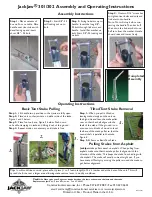
Adjusting the plow
38
To make a further adjustment when out in the field, on level ground,
drive the tractor's left front and rear wheels onto a block corresponding
to the depth you wish to plow and then lower the plow to the ground.
Ensure that the plow and the tractor's lower links are the same distance
from the rear wheels. Seen from the rear, the angle of the plow against
the ground must be 90º, which is achieved by adjusting the length of
the right lift arm. Seen from the side, the plow beams and the frame
must be parallel to the ground, which is achieved by adjusting the length
of the top linkage. The lower rear edge of the last landside must be clear
of the ground by approx.10 mm. The height of the top linkage on the
plow's tower must be selected so that the top linkage is slightly forward
against the tractor's attachment point.
The hole in the tower (A) is often used when plowing with 4 or 5-
share plows to ensure an equal depth on the plow forward and back
when plowing on hilly ground. To prevent the rear end of the plow
from tipping up on stony ground, the hole in the tower must be used;
this is more important the smaller the plow is. A narrow top linkage
angle gives unstable depth for uneven ground resistance. A wide
angle = stable depth.
The distance from the inside right rear wheel to the disc coulter or
share knife on the first plow body is adjusted using the turnbuckle (
B), which is parallel to the cross shaft, until the same plowing width is
set for the rest of the plow.
A
B
















































